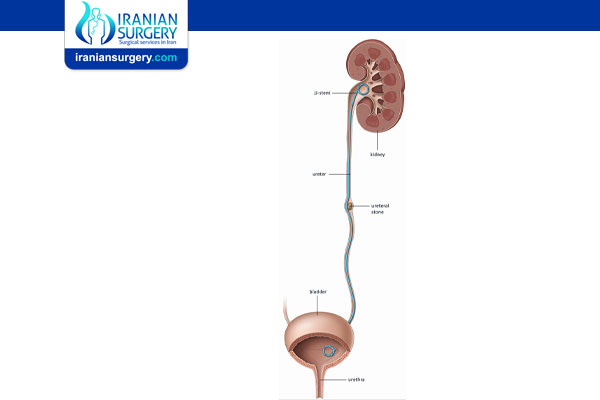double J stent
Double J Stent
What Is a Stent?
A stent is a soft, hollow, plastic tube. Ureteral stents are placed temporarily into the ureter which is the tube that drains urine from the kidney into your bladder. The stent allows drainage around a stone or can speed up healing after stone surgery.
What is a Double-J stent?
A double-J stent is a ureteral stent with curving ends that prevent the stent slipping into the bladder or the kidney. A Double-J stent is inserted to make sure urine can flow through the urinary tract.
Why Is a Stent Needed?
Stents are used for various reasons in patients with kidney stones. They can be placed to help reduce sharp pain from a stone (renal colic) or to allow drainage when infection is present or when a stone prevents a kidney from working adequately. Stents are commonly placed after surgery for stones (for example, ureteroscopy) to allow healing and to ensure that swelling does not block the drainage of urine after the procedure.
The Procedure
How Is the Procedure Performed?
The procedure is usually performed with the patient asleep (under general anesthesia). Sometimes a local anesthetic, with or without sedation, is administered.
During this procedure, a tube with a tiny optic camera is inserted through the urethra into your bladder. The bladder is inspected, and the ureteric opening is located. The urologist may use x-ray images taken with a contrast agent (dye) in the ureters to assess the urinary tract and to locate the obstruction.
The stent is placed during surgery by sliding it over a guidewire placed in the ureter (the tube that drains urine from the kidney into your bladder).
How To Prepare for The Procedure
Always ask your doctor about the treatment steps and any special instructions. These can differ by hospital and country.
Instructions may include:
. when to stop certain medications, such as blood thinners
. when to stop eating and drinking before the procedure to prepare for anesthesia
. when to empty the bladder before the procedure
. when to arrange pain medication after the procedure, if necessary—discuss this early with your nurse and/or doctor
. arranging for a ride home after your hospital discharge
What To Expect After The Procedure
The stent will be removed later on. Sometimes it is used temporarily before stone removal with another procedure.
Depending on the hospital’s protocol, you will proceed to the recovery room or to your own room after the procedure. Your blood pressure, heart rate, and pain will be checked regularly. Ask your nurse about visiting hours for friends and relatives.
You will likely leave the hospital shortly after the procedure, when you are able to empty your bladder sufficiently and you have no fever or not in too much pain.
You may feel mild to moderate pain in your lower abdomen, and you may have a strong urge to urinate. These symptoms are usually caused by the inserted stent. Medication is available to treat these symptoms. Do ask your doctor.
Double J Stent Aftercare
At hospital discharge, your doctor or nurse will give you instructions for rest, driving, and doing physical activities after the procedure.
Because surgical instruments were inserted into your urinary tract, you may experience urinary symptoms for some time after surgery. These symptoms usually disappear in a few weeks.
Symptoms may include:
. a mild burning feeling when urinating
. small amounts of blood in the urine
. mild discomfort in the bladder area or kidney area when urinating
. need to urinate more frequently or urgently
. pain resulting from an internal abrasion that needs time to heal
Try to drink fluids often but in small quantities. Sometimes a blood clot can cause pain (colic). The urine contains a substance (called urokinase) that will dissolve this clot.
If the pain remains despite the use of pain medication, contact the hospital or your doctor.
What Can I Do the First Week After Surgery?
. Try to drink enough fluids: 1.5 litres daily (in small quantities) throughout the day to facilitate urine flow and the spontaneous loss of small stone fragments.
. Try not to have sex within the first week after the procedure to avoid urinary tract infections.
. Eat more vegetables and less meat to have softer stool—the inner healing process will be helped if you do not have to squeeze when using the toilet.
. Allow your body to rest during the first week after the procedure—you are allowed to lift a maximum of 5 kg and to go for walks. You can start cycling and exercising after this period.
Double J Stent Surgery Follow-Up
When Is the Double-J Stent Removed?
During an appointment in the hospital, your doctor will tell you when the double-J stent needs to be removed. This can be in several days or within a few weeks.
How Is a Stent Removed?
Stents can be removed two different ways. Sometimes a string has been left attached to the end of the stent. This string is allowed to come out of the patient’s urethra (the tube that transports the urine from the bladder to the outside of the body). The string can be used to pull on the stent and remove it. If a string is not attached, numbing medication is usually administered, and a small camera called a cystoscope is inserted into the urethra. The cystoscope is advanced into the bladder along with a grasping instrument, which grasps and removes the stent.
When The Stent Was Placed During a Procedure for Stone Removal
If a stone is removed during the procedure, it is sent to the laboratory to determine its composition. This may take several weeks. Based on the laboratory results, along with blood and urine tests taken before treatment, your doctor can determine whether you are at high risk of forming new stones.
What If the Doctor Suspects That I Have a High Risk Of Forming New Stones?
If the results show that you have a high risk of forming more stones, your doctor will do a metabolic evaluation. This is a series of blood and urine tests to determine the possible causes of your stone formation. Depending on the test results, your doctor will recommend preventive measures or further tests. Besides changes in your lifestyle, you may be advised to take medication that reduces the risk of stones recurring. Generally, the medication will cause few to no side effects.
Changes In Your Lifestyle
Even if you have a low risk of forming another stone, your doctor and nurse will advise you to make some lifestyle changes.
Lifestyle changes may include:
. Increasing fluid intake: Drink 2.5-3.0 litres per day to neutralise the pH of your urine
. Adopting a balanced diet with less meat and alcohol and more vegetables and fibre to have normal calcium levels and less intake of animal proteins
. Maintaining a healthy weight and adequate physical activity
About Iranian Surgery
Iranian surgery is an online medical tourism platform where you can find the best urologists in Iran. The price of Ureteric stenting in Iran can vary according to each individual’s case and will be determined by an in-person assessment with the doctor.
For more information about the cost of Ureteric stenting in Iran and to schedule an appointment in advance, you can contact Iranian Surgery consultants via WhatsApp number 0098 901 929 0946. This service is completely free.
Source:
https://patients.uroweb.org/treatments/double-j-stent-placement/



